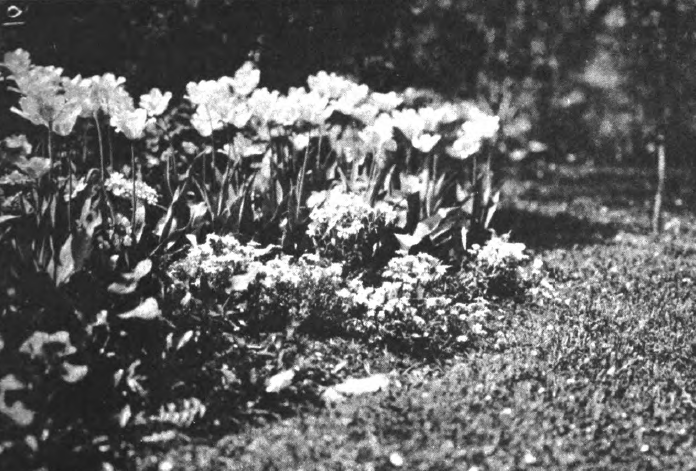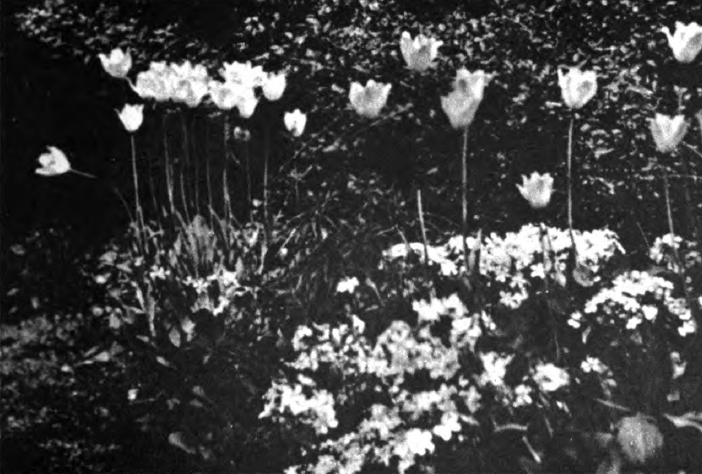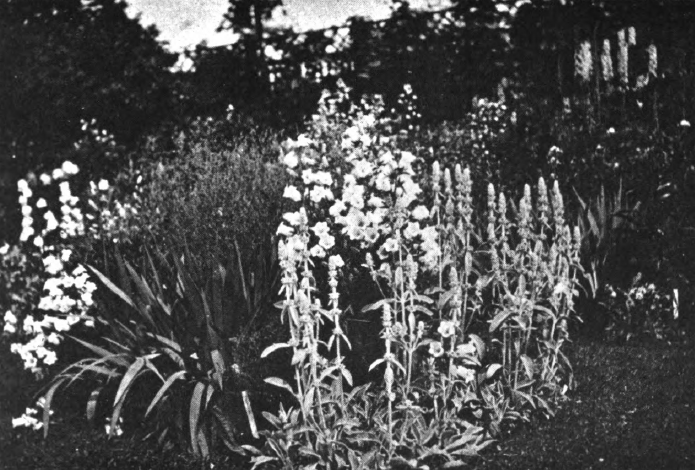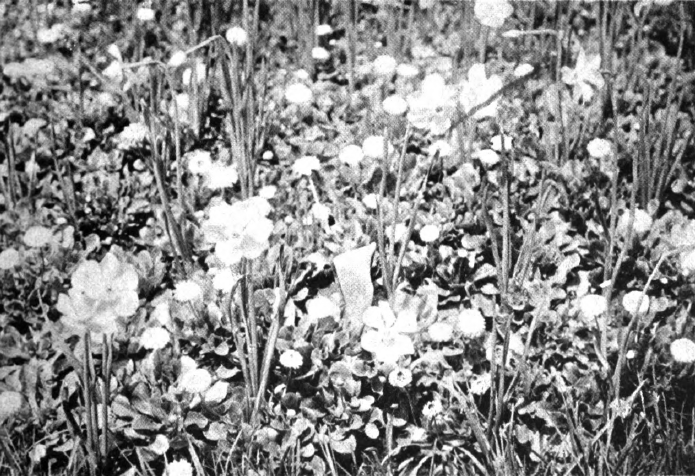| Web
and Book design,
Copyright, Kellscraft Studio 1999-2016 (Return to Web Text-ures) |
 (HOME)
|
|
"Along the lawns the
tulip
lamps are lit."
ROSAMUND MARRIOT WATSON.
COLOR ARRANGEMENTS FOR DARWIN TULIPS AND OTHER SPRING-FLOWERING BULBS I BELIEVE I shall always
remember
May, 1913, as the Darwinian May. As the mention of this adjective is
doubtless
music-to the ear of the scientist, so its sound is equally delectable
to the
possessor and lover of the Darwin tulips. In a bit of writing appearing
some
time ago in this journal, I set down a list of Darwins arranged for
color
combination, taken from a fine English source. These I tried for the
first time
this year; and I assure the reader when I saw them I fell down and
worshipped.
A pageant of color, a marvellous procession of flowery grandeur — no
words are
mine in which to tell of my sensations on seeing this beauty for the
first
time; and the sensations were not mine alone. They were shared by all
those who
saw them, among them some sophisticated eyes, eyes which might not show
delight
without good cause. The color arrangement
proved not so
good as I had hoped. And, thanks to an ingenious guest, we rearranged
for next
year in this fashion: One tulip of each variety was cut and labelled
with a
slip of paper. These cut tulips were then placed in the open spaces of
the rattan
or cane seat of a Chinese chair, the large flowers resting against the
back and
sides of the chair. The round openings in the woven cane exactly
admitted the
stiff stems of the Darwins; the background of basket-looking stuff was
most
becoming to the gay flowers, and at our leisure, seated in comfort
before our
tulip galaxy, we arranged and rearranged till the following plan
evolved itself
— a plan of which I append a rather feebly drawn chart — a plan,
however, which
I recommend with my whole heart, a Darwinian theory less abstruse if
not more
certain in its outcome than that of him in whose honor these noble
spring
flowers are named.  TULIP VITELLINA, PHLOX DIVARICATA  TULIP OESNERIANA ELEGANS LUTEA PALLIDA ABOVEHLO DIVARICATA LAPHAMI Another probably
successful
arrangement of spring flowers suggests itself. Why should not the tall
lemon-colored blooms of Tulipa Vitellina show back of rather close
groupings of
Scilla campanulata's lavender bells, while the tender yellow of Alyssum
saxatile, var. sulphureum, creates a charming foreground? The three
flowers
bloomed with me this year at the same time, and I cannot but advise a
trial
planting of them together — say a dozen of the tulips, fifty scillas,
and six
or seven roots of the beautiful hardy alyssum, and you have a picture
which a
true "garden soul" will feel beneath the ground in winter. This could
be done in a spot apart, a bit of ground sacred to adventures in
flowers. And while we are on
adventures in
flowers, may I impart a few impressions of some tulips seen this spring
for the
first time? Really revelations — some of them unspeakably beautiful.
Coming,
for instance, unexpectedly upon Tulipa viridiflora was like coming upon
a
specially beautiful green-and-white trillium in a wood. This tulip has
that
precious look of not having been evolved. Yet it is a May-flowering or
cottage
tulip. What pleasure in a few bulbs of this unique flower, in its
aspect of
untouchedness! It cannot be possible, one thinks, that the delicate
bands of
green up and down its palest yellow-painted petals were not set there
by the
skilful eye and brush of perhaps the Japanese! Tulip The Fawn, a Darwin
this, was
almost unbelievable in its beauty. No description of it in print
satisfies me.
May I here give my own? Pale amber to cream-color outside, suffused
with soft
pinkish lavender, the whole effect that of a tea-rose. Why not give it
a
subtitle — the tea-rose tulip? And why not grow it with that deep, rich
purple
Darwin Faust? The contrast between these two is tremendously striking,
yet
there is a certain harmony of tone which allows of their dwelling
together not
only in peace but in beauty. Gudin, a tall tulip of a
pale-mauve
hue, looking its best near a group of the stately Innocence, was
another of the
wonders of the spring. Orpheus was a charming flower turning to warm
rose in
its last days; Emerald Gem, oddly named when its richest of 'salmon
blooms are
considered, with Orange Globe should form a combination of brilliant
color
unsurpassed; and in Dom Pedro we have a Breeder tulip, a flower of
wonderful
mahogany tones which I should ever choose to see associated with
Coridion,
lovely "clear yellow with stripe of lilac through centre of petal." About June 3 comes
Ixiolirion
macrantha, like a small lavender lily, with delicate tubular flowers,
as many
as a dozen up and down the graceful waving stem. The leafage of this
flower is
scanty; what there is, is of a grayish-green which makes the flower a
fit
companion for the dusty miller (Senecio cineraria). The ixiolirion is
one of
the bravest of bulbs, coming triumphantly through the bitter frosts of
last
winter. lxiolirion pallasi is named as a good one, and this I hope to
try. The
lasting quality of ixiolirion in water is one of its recommendations;
and
because it is so very perfect when cut, if used with sprays of Deutzia
Lemoineii — for daytime use on the table, that is, for I have yet to
find the
blue that can properly be used under artificial light — I hope to let a
quantity of these beautiful waving things blow near and before the low
bushes
of the deutzia next spring. These will follow the tiny Italian Tulipa
clusiana,
whose slender beauty grows dearer every year. Clusiana is neighbored by
Puschkinia and the two are preceded by some species of crocus — the
Scotch, I
think, var. C. InYlorus pusillus. So we achieve an uncommon
spring
planting, delicate and lovely for weeks from the end of April to the
first of
June, always interesting whether the small flowers are coming or going
— and if
planted with judgment and discrimination as to natural-looking
arrangement,
regard to height and color, we may without fear of disappointment think
in
December of the rare joys in store for us in that spot when it shall
have been
touched by the suns of spring. A charming happening has
just taken
place in the borders. The bush honeysuckles of Michigan were never more
gloriously covered with their veils of white and rose than this spring.
It may
have been the gradually warming season, the uninterrupted progress from
leaf-bud to blossom; in any case, the tale is the same all about us —
the
loniceras have been remarkably fine. Below a towering group of
Lonicera, var.
bells albida, whose flowers in early June are just passing, crowds of
the
swaying long-spurred hybrid aquilegias bloom and blow. Most of us now
know the
unusual delicacy and range of color in these charming flowers — faint
pinks,
yellows, blues, and lavenders — all pale and poised as they are. But oh! to catch beyond,
under the
shadow of the honeysuckle boughs, as I did but now, the sight of masses
of
blooming pink scillas, Scilla campanulata, var. rosea, at precisely the
moment
and in precisely the place where its modest beauty was most perfectly
displayed
— to have this as a surprise, not a special plan — here was a pleasure
of a quality
all too seldom felt and known. Nothing could carry on and repeat the
tones of
the pink and lavender aquilegias as does this loveliest of late
scillas. In
appearance more like a tall lilyof-the-valley than any other flower I
can call
to mind, in tone so cool a pink that it is perfect in combination with
the
blue, lavender, or pink columbines. It is enchanting as their neighbor
and far
more interesting thus used than in the more commonplace proximity to
its cousin
or sister, the lavender Scilla campanulata, var. excelsior, blooming at
the
same time. To me it would be dull to see sheets of these two spring
flowers
near each other or intermingling. Dull, I mean, compared with such a
possibility as the combination I have tried to describe and which was
simply
one of those heavenly accidents befalling all too rarely the ardent
gardener. On this June day the buds
in my
garden are almost as enchanting as the open flowers. Things in bud
bring, in
the heat of a June noontide, the recollection of the loveliest days of
the year
— those days of May when all is suggested, nothing yet fulfilled.
To-day I have
been looking at something one of these photographs feebly tries to show
— tall
spikes of pale-pink Canterbury bells, the flowers unusually large,
standing
against a softly rounding background of gypsophila in bud; to the left
of the
campanulas, leaves of Iris pallida Dalmatica, so tall that their
presence is
immediately felt; a little before, but still to the left of the pink
spikes and
the iris, perhaps a dozen tall silvery velvet stems of Stachys lanata,
whose
tiny flowers give but a hint of their pale lavender as yet, and are
lost in the
whiteness of the young leaflets, and — and this is the thing which
really
creates the picture — three or four spreading branches, a foot from the
ground
and directly below the campanulas, of Statice incana Silver Cloud, tiny
points
of white showing that the whole dense spray will soon be full of
flowers. Below and among the
campanulas
(which I keep in bloom a very long time by a careful daily taking off
of every
shrivelling bloom) stand 'salmon-pink balsams, these to replace with
their
two-foot masses of flowers the campanulas when the latter's day is over
and to
rise above the gray-white leaves of the stachys when its blooming time
is also
past. This stachys is a lovely adjunct to the garden. The texture of
its leaves
is a matter of surprise to every one who touches them. Most people
would call
stachys "woolly," but I do not like this word — (is it because I live
in the West?) — and why apply an unpoetic word to any one of the lovely
inhabitants of our gardens? It came about that a
space before
the bush honeysuckles — the pink flowering variety, Lonicera Tatarica,
var.
rosea — in a border, needed filling with lower shrubs. The piece of
ground to
be furnished was perhaps fifteen feet long by three wide, though
irregular in
both width and outline. Last autumn Rosa nitida had been there set out,
planted
about three feet apart. Bare ground for this year and next was sure to
spoil the
look of things while these roses were yet young, and a covering for it
was thus
managed. Canterbury-bell plants were distributed in small groups among
the
roses, especially toward the back of the border; and English irises,
Rossini
and Mr. Veen, were tucked in in longish colonies before and among the
campanulas. In ordinary seasons these irises might not have bloomed
with the
campanulas, but this year it was Monte Cristo-like — the flower and the
hour! —
with a resultant superb effect of color. Mr. Veen, a true violet iris,
Rossini,
a purplish-blue, were good together to me, who differ from Miss Jekyll
in
possessing a penchant for blue combined with purple or with lavender.  PINK CANTERBURY BELLS, STACHYS LANATA  From The Garden Month by Month. By courtesy of Frederick .A. Stokes Company BELLIS PERENNIS AND NARCISSUS POETICUS To compare a bloom of one
of these
irises with a spray of the Dropmore anchusa is to get an extremely
vivid and
interesting idea of the effect of colors upon each other. Taken alone,
Iris
xiphiaides, var. Mr. Veen, is a blue without very much purple in its
tone;
beside the anchusa all the blue vanishes — the iris is a distinct
purple; place
it beside Rossini, it becomes blue again; and grow masses of Rossini
below the
anchusa, especially the variety Opal, and there is one of the most
beautiful
juxtapositions possible in flowers — so far as I know an original
combination
of color and one to charm an artist, I believe. Anchusa of a year's
standing, a
three-foot anchusa, might be best to use in this way. The two-foot iris
would
prove a good companion. There follows, soon after
the
gray-and-pink combination in my garden of which I spoke a few
paragraphs back,
the combination of pink Campanula medium and Stachys lanata, a time
when one of
the loveliest of all double poppies lights up the little place with
color. For
this poppy — an annual — there is no registered name. It is double,
extremely
full, perhaps three feet in height, and of a delicious rosy-pink,
exactly the
pink of the best mallows;, or of the enchanting half-open rosebuds of
the
ever-lovely rambler Lady Gay. To see three or four of these poppies in
full
bloom among the white mist of gypsophila, either single or double, the
oat-green of the poppy leaves below, is to see something more
delicately
beautiful than often occurs in gardens. Many packets of the seed of my
poppy
are always in readiness, as I have a superabundance of the same; and if
ten
people read these words, and if, peradventure, there be ten gardeners
with
vision to see through the veil of these sentences the rose-pink beauty
of this
flower, let them ask for a bit of this seed, for it is theirs for the
asking! The love of flowers brings surely with it the love of all the green world. For love of flowers every blooming square in cottage gardens seen from the flying windows of the train has its true and touching message for the traveller; every bush and tree in nearer field and farther wood becomes an object of delight and stirs delightful thought. When I see a rhubarb plant in a small rural garden, I respect the man, or more generally the woman, who placed it there. If my eye lights upon the carefully tended peony held up by a barrel hoop, the round group of an old dicentra, the fine upstanding single plant of iris, at once I experience the warmest feeling of friendliness for that householder, and wish to know and talk with them about their flowers. For at the bottom there is a bond which breaks down every other difference between us. We are "Garden Souls." |